

SEO content often gets a bad rep for being keyword-stuffed and written for search engines only. Well, we’re here to show you there’s much more to it than keywords. Read on to find out in detail what SEO-friendly content really is, what us SEO content writers are really after, and how to write good SEO content step by step.
SEO-friendly content is the type of content created for people first but always optimized with the goal of performing well in search engines. SEO-friendly content is created for people and optimized for Google.
Yes, we do keyword research, but we do it primarily to find out what people are interested in reading about and how they are looking for it. By knowing the what and how we make sure our content piece has an audience before being written.
So, writing with the intent of ranking well on Google, in its essence, isn’t a bad thing. It simply means we want our content to be accessible to users and get the visibility we work hard for it to deserve.
Therefore, we won’t deny that using keywords is important; but stuffing a piece of content with keywords does not make it SEO friendly. (Un)fortunately, it takes much more than that, and that is what we’ll explore in this guide.
The writing process, ironically, doesn’t start with writing right off the bat.
Before coming to the point of starting to create a content piece, it needs to be brainstormed, researched, evaluated whether it fits the client’s audience, planned, and finally assigned. These things get defined when you have in place:
Let’s go over the importance of each of these briefly.
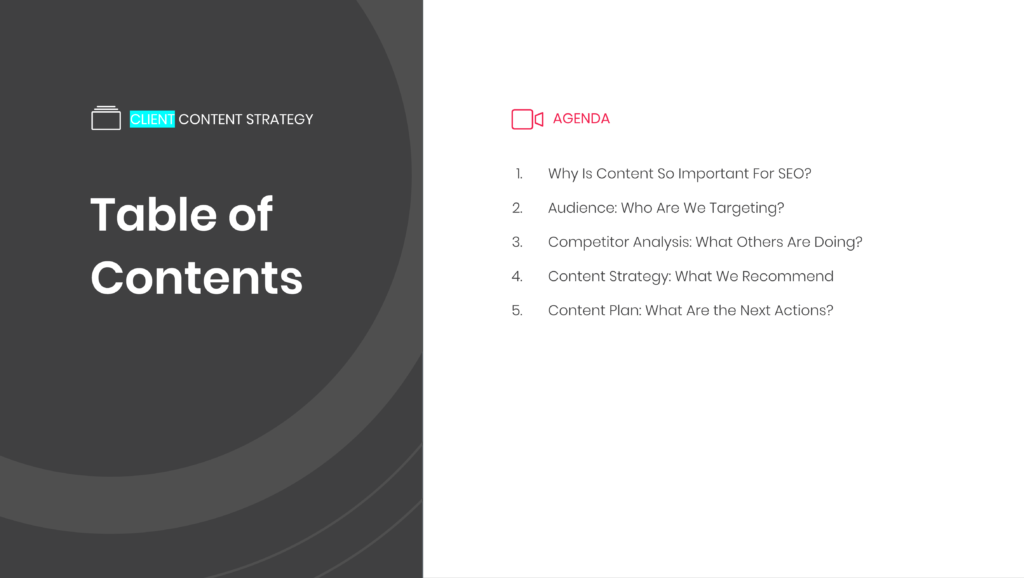
A content marketing strategy includes the planning, creation, delivery, and management of content for a company. It is essentially the backbone of everything content marketing-related you do. It gives answers to questions such as:
The importance of having a content strategy is huge. It is always the first thing we do to kickstart a new project. However, a content strategy is not something to be made and left to use for months or years on end; it should be refreshed and updated at least every 6 months.
A content calendar, otherwise known as an editorial calendar, is a schedule created monthly, quarterly, or annually that plans upcoming content, relevant details for each content piece, and when it is to be created/published.
Having a content calendar is definitely a necessary way for an editorial team to stay organized. The head of content knows at all times what content writers are working on, and doesn’t need to ask for the link to a finished content piece; it is in its designated place under the Google Drive URL column. We create these monthly for each of our clients after doing keyword research.
As you can see below, we use Google Sheets for our calendars. We like simple spreadsheets as they give a clean, simple overview of the content plan with no unnecessary complications. However, there are options when it comes to spreadsheets. Tools like Airtable or other Airtable Alternatives and CoSchedule work like spreadsheets but offer extra features.
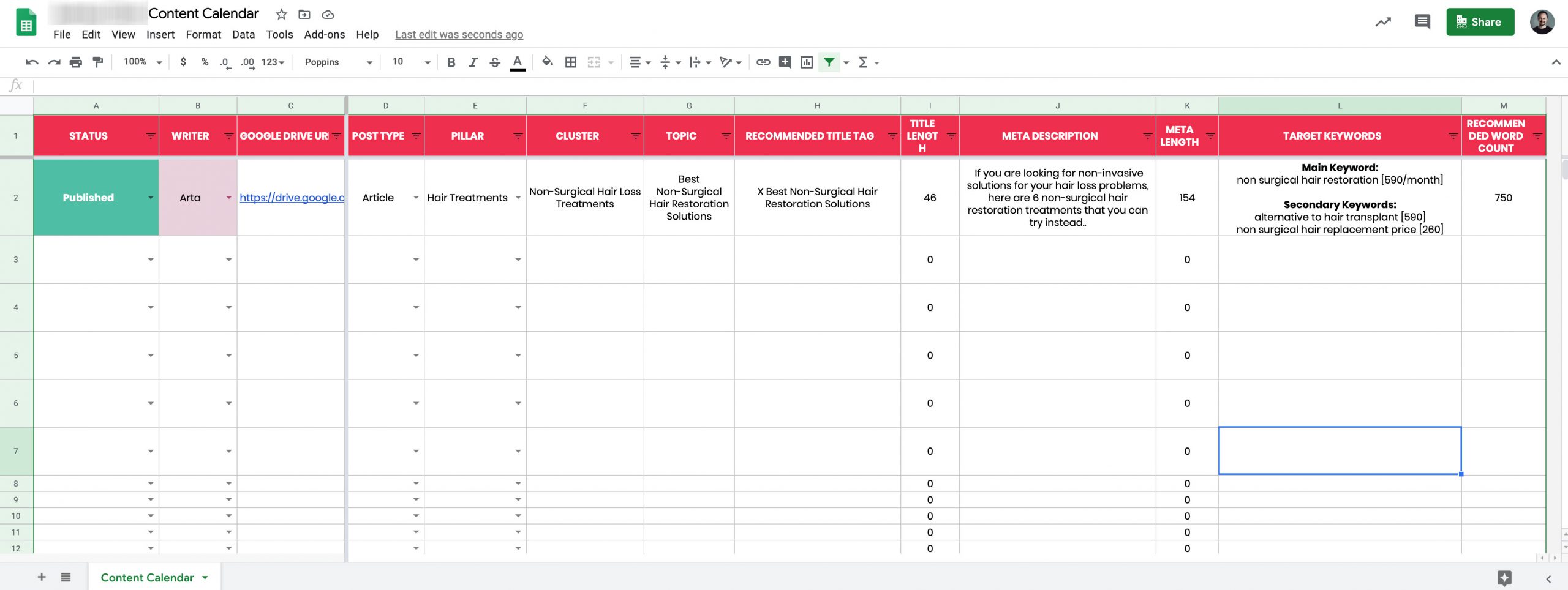
A content style guide, also known as an editorial style guide or simply style guide, is essentially a set of comprehensive language guidelines that aim to bring consistency to content written for and about a brand. It is created by the content specialist/manager in coordination with the client and is meant for all content writers to follow. This ensures consistent branding across all published content whether it is for blog posts, guest posts, copywriting, ad copy, etc..
The most important points to cover on your guide are:
Before creating a content style guide (and even before creating the content strategy), it is advisable to prepare a questionnaire to give to the client for completion, wherein you’d ask questions like:
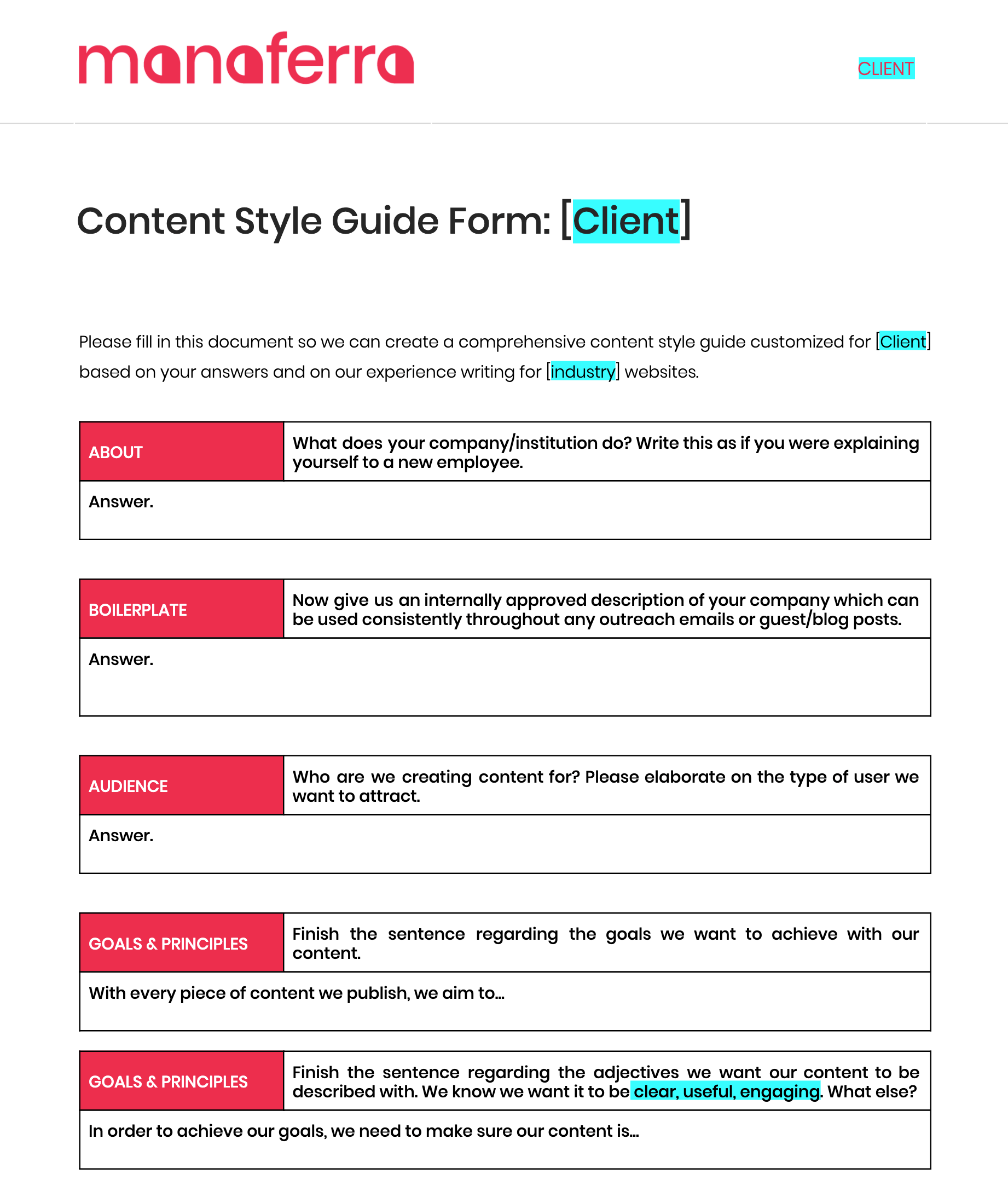
Although we at Manaferra always take these 3 important steps before assigning a task to a content writer, we are aware that not all agencies (or freelance writers) do it. One other great example is Austin Mullin’s process for scalable content marketing.
The process below is for when you are given the task to write an article on a topic with no further details.

You need to have an idea of what you want to write about before deciding on the specific keywords you want to target. Let’s say we want to write about Types of Employee Training Programs and let’s use this example throughout the process.
At this point, you’re to do general research on the topic and see what’s popping first on search results. This general research is done to see what people have written before and to have a clear idea of what you can bring to the table; what value can you add to what’s already been done. If you see impressive pieces, you might want to keep those tabs open for when you do competitor research.
By quickly skimming through the top SERP results, we can see they write about orientation training, leadership training, onboarding training through the help of an onboarding software, and more.
Information taken from Harvard Business Review or The New York Times will more likely be true and valuable than from a web page that does not seem familiar. But, with the multitude of websites that exist on the web, it’s impossible to know them all. So, if you found good information in a site you don’t recognize, check the following to evaluate its quality:
Yes, they are competition, but they’re doing something right since they’re ranked so highly on search results. It’s okay to take information from them as long as you reference them. Also, do so as long as the topic they are writing about is not exactly the same with what you are writing and you are not targeting the same keywords they targeted. In that case, you would be promoting the article that you are competing with. It wouldn’t make sense.
So be careful with it and don’t overdo it; do not exclusively look into your competitors for inspiration and article sources. After all, they’re your competitors and if you keep linking back to them in every article, then why would Google rank you? Keep in mind that your goal is to write a better, updated content piece, so you should always be trying to make it unique and of high value.
Don’t reference outdated articles unless they’ve been updated recently. It’s safer to go for articles that have been written in recent years, especially if what you’re writing about is something that is a trend.
This doesn’t apply to all cases (the majority of them, yes). In the end, our goal is to reference the right article with the right information that we need. If it’s a few years older but it’s the original source, then we link back to them.
The fuller the article, the more time and effort was spent on it.
Also, don’t forget to check the credentials of the person who wrote it. Yes, actually read the bio of the author. Someone who specializes in SEO has greater authority to write about SEO than someone else from a more general field.
Read all online articles with a critical eye, but if a scholar article is written from a .edu TLD, it has greater potential to be more trustworthy than a .com one.
Also, create a free account on Moz.com and install the MozBar extension in Google Chrome. In the top right corner of your browser, you’ll see a number (metric) for each website you open. It’s called the ‘Domain Authority’. It’s on the scale from 0 – 100 and the higher it is, the higher the domain authority for that website is.
This doesn’t mean that you should exclude websites with lower DA (Domain Authority) or only use the ones that are higher than 50, but you should think of this tool as a quick way of validating your thoughts for a specific website (if you see the site has a terrible user experience, the content is ‘meh’ and the DA is low, you ignore that source).
Another great tool that we use on a daily basis for this and other features is Ahrefs. It’s an essential tool for anything related to SEO, and we couldn’t recommend it enough.

After our general research, we continue with keyword research by which we will find our main and secondary keywords.
After we have the topic we want to write about—Types of Employee Training Programs—we need to find a relevant keyword for which we see potential we can rank for. This keyword we will target needs to:
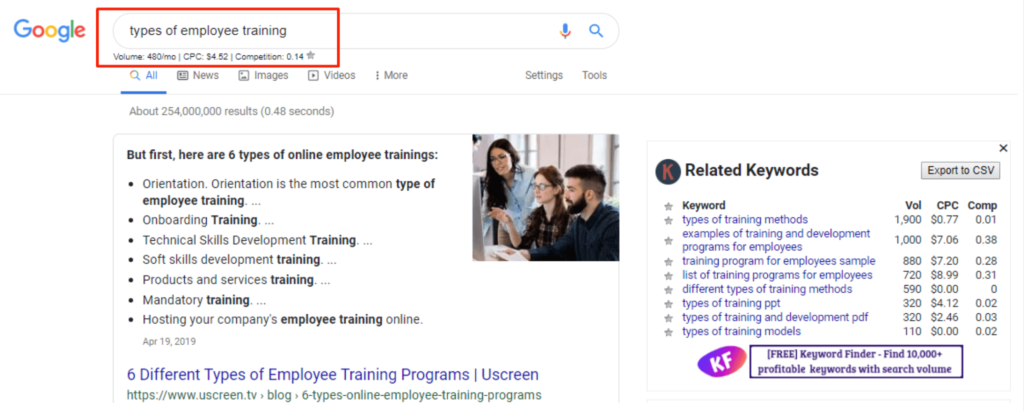
Using the Chrome add-on Keywords Everywhere or Ahrefs, we can check the volume of the keywords we try according to the topic. “Types of employee training” fits our topic and has enough searches, therefore it is the chosen main keyword.
Another good resource to figure out what people are searching for is AlsoAsked.com. Sometimes, it can be as accurate as to write your whole outline for you.
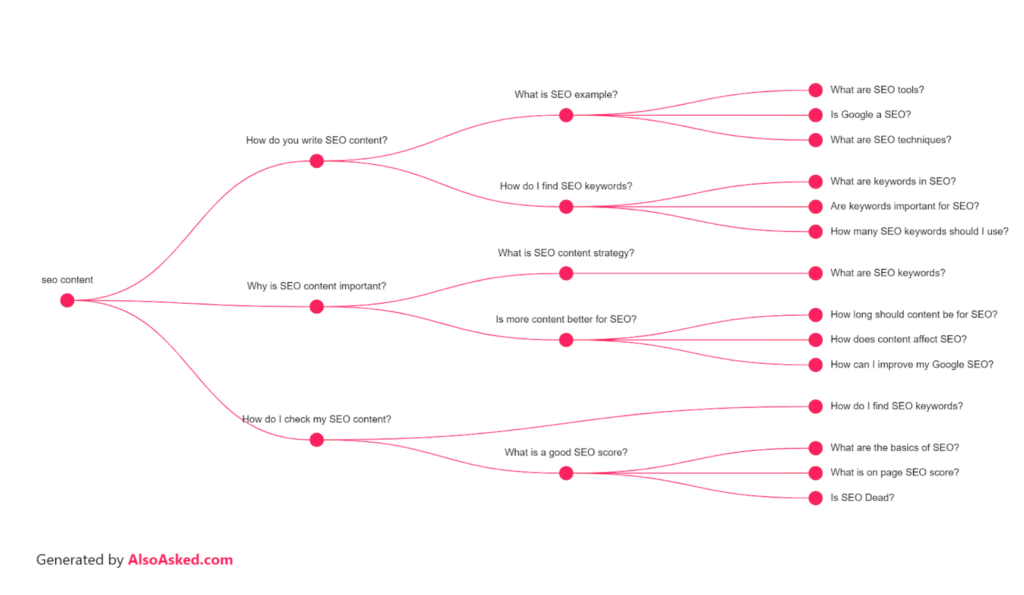
Supporting keywords (also known as related or secondary keywords) can be found in different ways. Some of them are:
We choose them by using common sense and by checking the volume of searches. Have in mind we want to have a resourceful content piece, so we want to also include all related things that people expect to find in the article you’re writing about. E.g. We anticipated that people who click on this guide (yes, this one you’re reading right now) will want to learn about all things related to SEO-friendly content, such as image optimization, keyword research, internal linking, etc. So, we planned them ahead in our keyword research and then placed them in headings.
Having a template with the right fields to place those awesome keywords you found and their search volume makes things much easier every time you start a new piece. Here is ours:
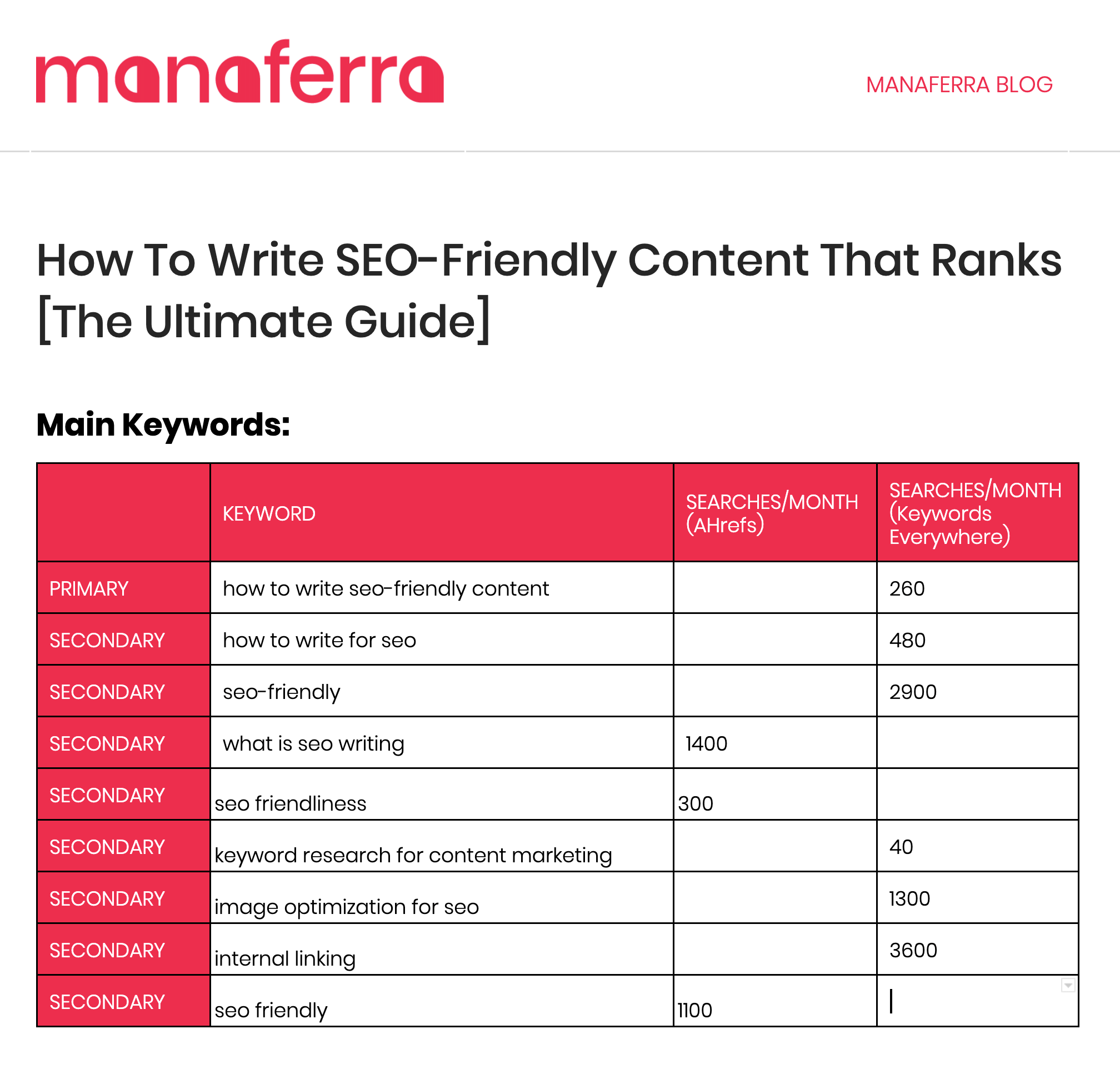
Finding them doesn’t work without using them. So, once you start writing, use the keywords in the title, permalink, headlines, meta descriptions, ALT tags, and main copy.

Writing metadata is among the best and most necessary ways to help the search engine understand the contents of that page. So, special attention should be paid to writing and optimizing them.

Metadata serves to describe and give information about other data. The types of meta tags you need to pay special attention to are:
Our blog post (Google Docs) template has a table designated to fill in the metadata which we then transfer to our Yoast SEO plugin in WordPress.
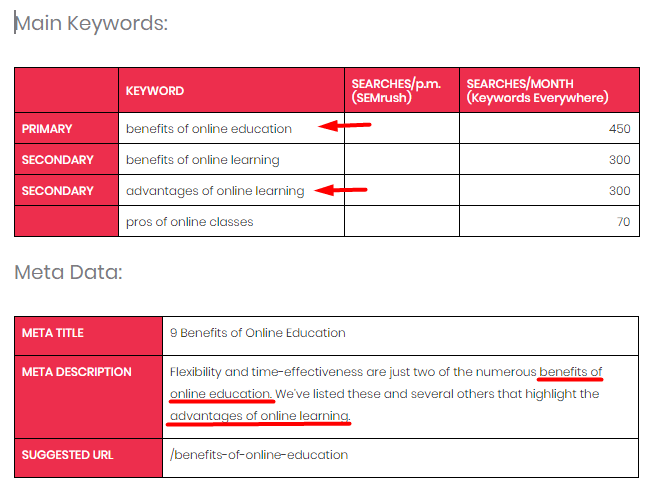
The title is the fundamental part of any text. Mess it up and you’ll have no one to actually click to read your perhaps wonderful piece. Apart from people, it’s also one of the most crucial factors when it comes to search engine-driven searches.
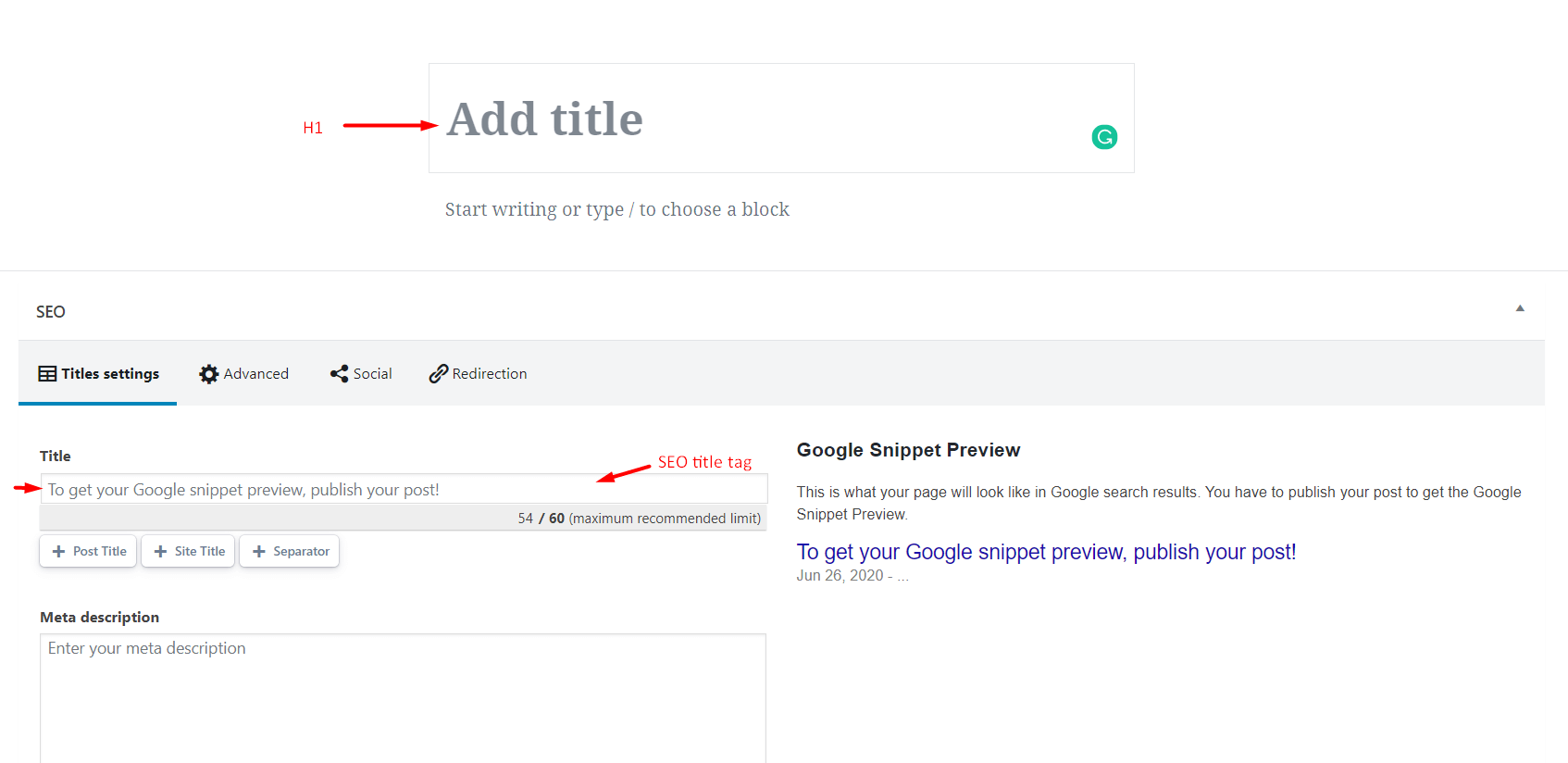
There’s actually a difference between the page title (SEO title) and the H1 heading (article title) which us SEO content writers should pay attention to.
While your H1 heading is meant for people already on your site, your SEO title shows up on search results—therefore, to people who aren’t on your website yet. For this reason, more attention should be paid to it to write a compelling title to encourage prospective visitors to click. The SEO title is also the one that search engines consider during the crawling and indexing phase. So proper keyword(s) should be implemented in the title tag.
While keeping the same title is also possible (and will be kept so unless you change it), it is advisable to always have an optimized SEO title where your main keyword is used and the length is under 60 characters so that the full title is shown on search results. To make sure your SEO title meets this requirement, you can use a character-counter tool that counts both characters and words. As for H1s, you can be less restricted to following any rules.
Here are some things to keep in mind when writing your next SEO title tag:
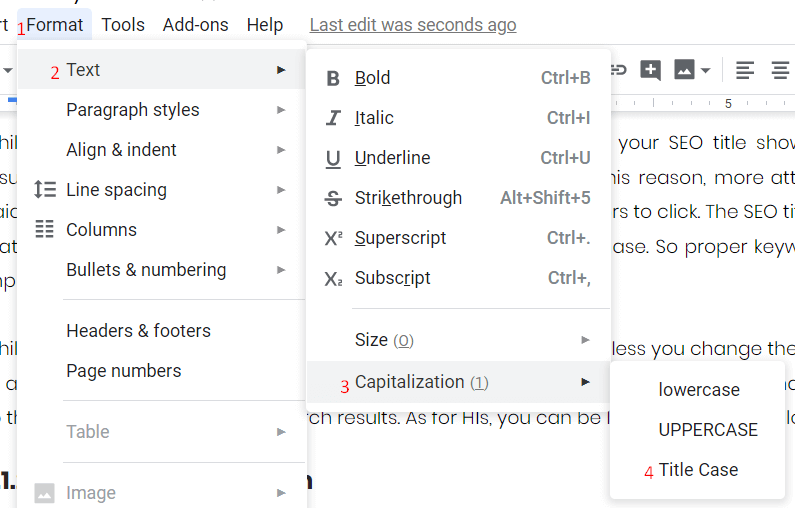
Your meta description is the sneak peek to your content piece. So, make it captivating. Use your summarizing skills to come up with an under-160-character text using the main keyword. Make people click by giving them a taste of what your article is about.
The better the MD, the better the CTR.
On writing meta descriptions quickly and efficiently: state what the article is about by mentioning the headings. (Therefore, you write your meta description after you finish up your piece.) This way, you get to use the secondary keywords in the meta description, too, in addition to the main one which is a must. Apart from being a great way to tell Google what the piece is about, you are also bluntly telling the reader what they’ll get if they click.
Let me illustrate this for you.
This was the table of contents of the article named Studying Abroad: The Only Guide You Need:
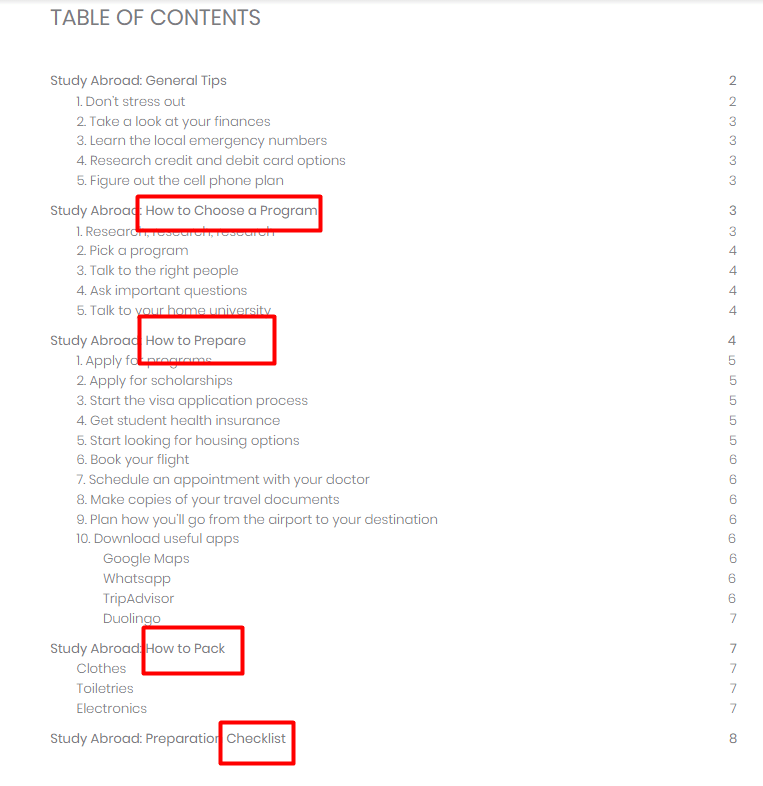
And this was the final meta description. Notice the keywords in bold.
If you want to study abroad in the U.S., here’s a study abroad guide to help you with the process, including how to choose a program, how to prepare, how to pack + a checklist.
When publishing an article on WordPress, the title will be generated as the permalink (the URL of the article). It is usually very long and contains unnecessary linking words.
We want to keep that URL as short as possible and make sure that it has the main keyword on it. So we need to edit it.
For example:
Title:
How to Transfer Colleges? Step-by-Step Guide to Transfer Like a Champ
Auto URL:
/how-to-transfer-colleges-step-by-step-guide-to-transfer-like-a-champ
SEO-friendly URL:
/transferring-colleges-guide

Time to write… sort of.
After you’ve done your research on the topic, write whatever goes through your mind. It doesn’t have to be refined or final yet.
I like this analogy by SEO-Hacker advising content marketers to think of the audience while creating the outline. We must, indeed, ask ourselves questions like:
“What would I want to read about?”
“Does this interest me?”
“What am I looking for?”
Try to answer these questions in the headlines you create and be as straightforward as you can. If you want, you can also leave notes to yourself in the body, so that you don’t forget later to write what you have in mind now.
E.g. this is what this guide looked like at the point of being a simple outline, before becoming a 5000-word piece.
The outline is the perfect time to write your headings and placing your keywords in them.
Yes, now.
Us at Manaferra don’t believe in optimizing the content piece AFTER all the writing has been done. We think that inputting the keywords in such a way makes them look a bit out of place. So, after trying many different methods, we have found this one to work—basing the content piece ON the selected keywords.
All the H3s, H4s, and so on don’t need to all be defined now. That’s a bridge you’ll cross when you get there.
Headings are something the whole internet should thank SEO for.
They make a piece of long-form content structured, easily-digestible, and, generally less overwhelming. As much as it pains us, writers, to hear this, let’s be honest: people don’t read our articles word by word.
In fact, a study has found that only 16% of internet users read an article from start to finish. 79% are scanning. They mostly read the headlines and stop to read the paragraphs when something catches their eye.
So be ready for some readers to see your article like this:
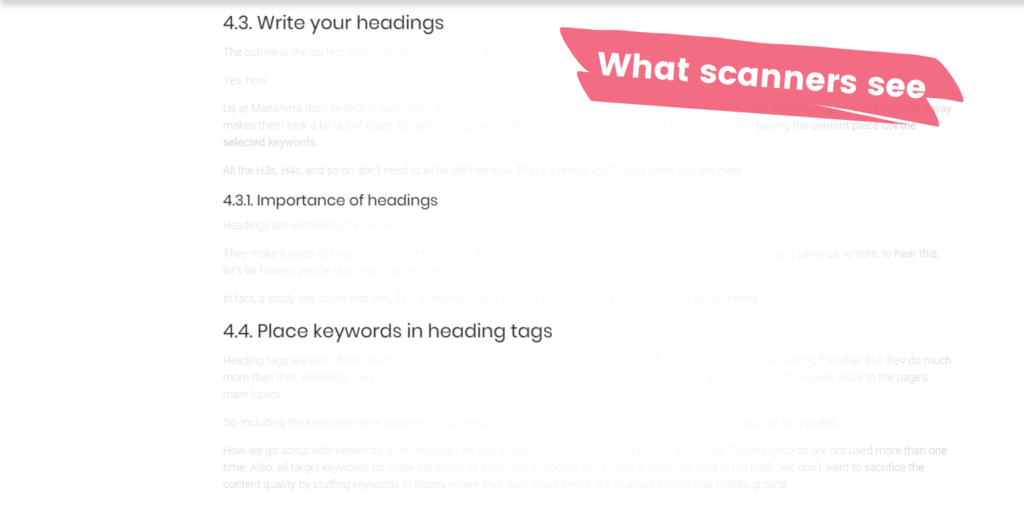
As mentioned before, this is actually a step done simultaneously with writing the headings. We’ve mentioned headings for quite a bit now but didn’t really explain what they are and why they’re important.
So, here goes.
Heading tags are part of the HTML coding of a webpage. Yes, they are a big part of neat formatting and make the reading friendlier, but they do much more than that. Headings carry a lot of weight with the search engines, helping with categorization and giving search engines clues to the page’s main topics.
So, including the keywords we’re targeting inside Heading tags is second-nature to us at Manaferra, and should be for you too.
How we go about with keywords is: on headings, we add at least one of the main/supporting keywords. Target keywords are not used more than one time. Also, all target keywords (or close variations of them) are supposed to be used at least one time in the body. However, even though we do pay attention to keywords, we don’t want to sacrifice the content quality by stuffing keywords in places where they don’t make sense. It’s all about finding that middle ground.
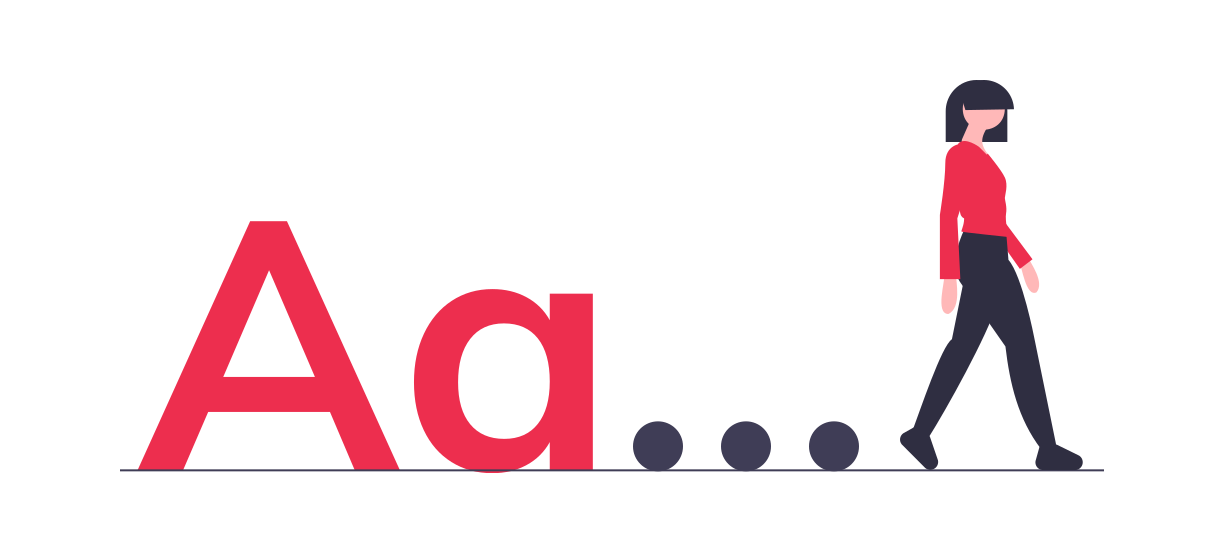
At this point, you’ve set everything up for success.
It’s time to go over your outline and fill in the blanks. You have everything you need to finish up this piece:
Depending on your topic, start expressing the thoughts you’ve developed from your research and the information backed by sources you’ve gathered. Try to keep your writing clean, clear, and easy-to-read.
You’ll find countless content writing tips on the web—all great ones. But, (yes, there’s a but) they look like they’ve been written by writers.
You might be eye-rolling and saying “Duh!” right now.
And you’re right. They will obviously be written by writers. My point being, I have not come across articles written by editors—the ones actually dealing with reviewing and perfecting other writers’ writing daily.
Well, I am one. So, here are a few very specific comments I tend to give content writers on their writing:
Just because you’ve been tasked with “promoting” one thing, doesn’t mean you should “trash-talk” everything else. Be respectful to competitors. Here’s an example of a problematic sentence, and the comments made to it phrase by phrase.
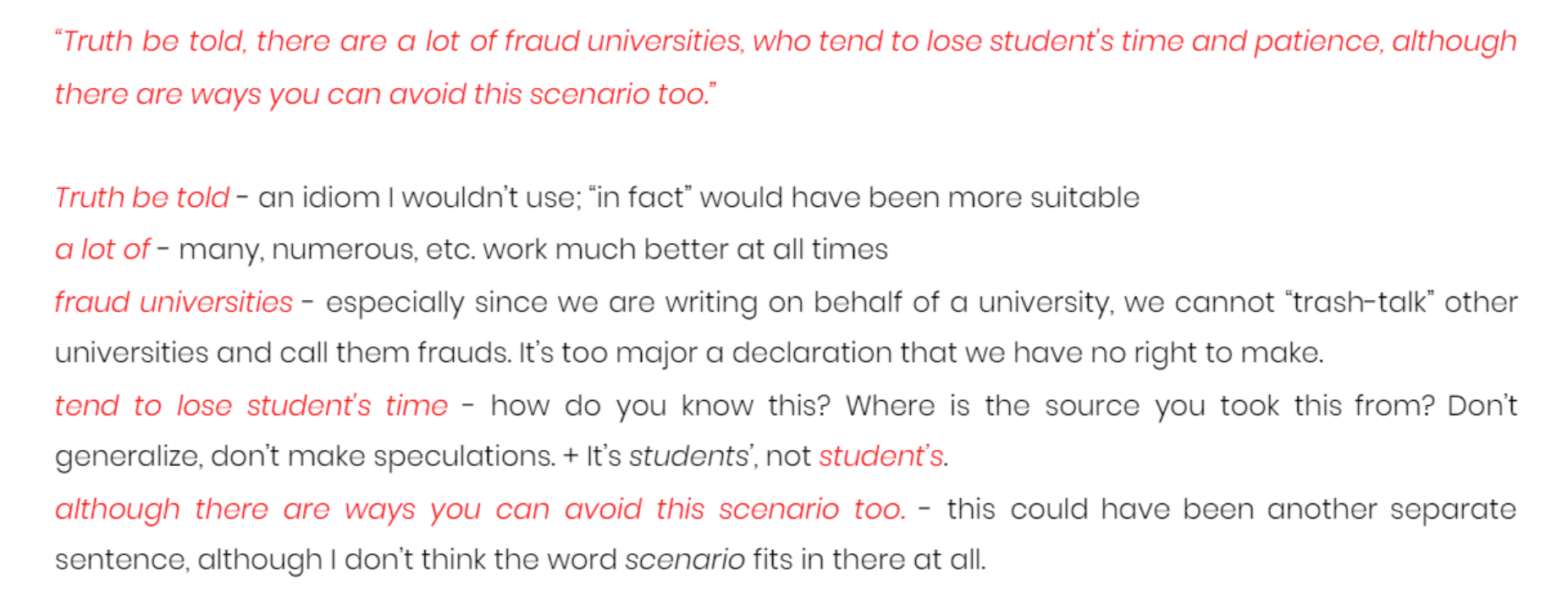
Language has changed. And for the better that is. Use these two tips so that you’re always respectful and inclusive in your writing.
As a study on sexist language found out, when readers see the generic pronoun “he“, they assume the gender of the person being described is a male. So, if you use this sentence on your blog ‘Every person deserves his freedom.’ or ‘A painter knows his brushes.’, your readers will have the image of a man in their heads when they visualize what they’re reading.
Similarly, using the pronouns “him or her” or “he/she” can also be problematic since that person might not identify themself with either pronoun.
The singular “they” has become best practice in recent years because it is inclusive and helps writers avoid making gender assumptions (or careless slips), as APA also advocates. So, as APA (and most style guides) advises, always use the singular “they” in these two occasions;
The singular gender-neutral pronoun “they” has gotten the seal of approval by APA Style as of 2019 and Merriam-Webster selected it 2019’s word of the year. Other style guides such as the Associated Press Stylebook, the Chicago Manual of Style, the MLA style manual, have also accepted the usage of the singular “they”.
As for Grammarly, I guess they haven’t, yet.
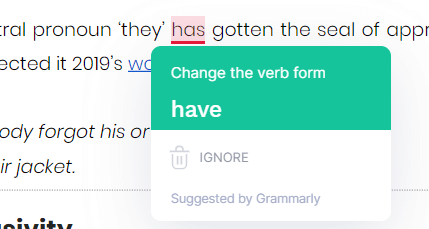
So next time you say or write: Somebody forgot his or her jacket.
Consider using this version instead: Somebody forgot their jacket.
Similar to the singular “they”, there are a few terms we find ourselves using on a daily basis unknowing of the fact that there are better, more inclusive alternatives we could go for.
| Instead of this word… | Use this one |
| mankind | humankind, humanity |
| fireman | firefighter |
| the best man for the job | the best person for the job |
| waiter, waitress | server |
Your name might be on the bio, but most often than not, you’ll be writing for a client, i.e. for someone else’s brand. So, be very careful with what you say since you’ll be representing them, not just yourself.
Don’t be disrespectful to any community, company, industry, etc..
Always either give the name of the study, website, article, or link to them. We know from our own experience we like our work to be credited when it is used, so of course, we must lead by example.
Oh, and no need for the .com part.
Say According to Manaferra, instead of According to Manaferra.com.
The word data might be plural but does mean it can’t be used with verbs in their singular form, such as saying: Data is important? Well, no, because it has been established in such a way that it is acceptable and even preferred.
It’s not enough to restructure the sentence or use a synonym of the main verb or the linking word. Do take information from other sources, but don’t copy and paste and then try to patch it up.
Writing about a piece on Time Management Strategies for Online Students, and linking to another blog post that wrote about the same thing, has a similar title, and has the same style of writing is not a good idea. They’re probably a competitor.
Synonyms are our best friends in these cases.
Sure, embellished sentences are beautiful; but they can unnecessarily lengthen a sentence. Leave them for your fiction projects, but go for brevity in SEO content writing.
E.g.
Instead of: Honesty in the field of accounting has always held great importance.
Just say: Honesty is crucial in accounting.
Grammarly is a great tool for any writer—SEO, or not. It is great for detecting grammatical issues, hard-to-read sentences, engagement, etc..
So, after you finish the writing part of your content piece, paste it to the Grammarly Editor and let it be your proofreader. On the right side, you’ll see the alerts it gives. We suggest addressing their suggestions until you get a performance score of at least 80.
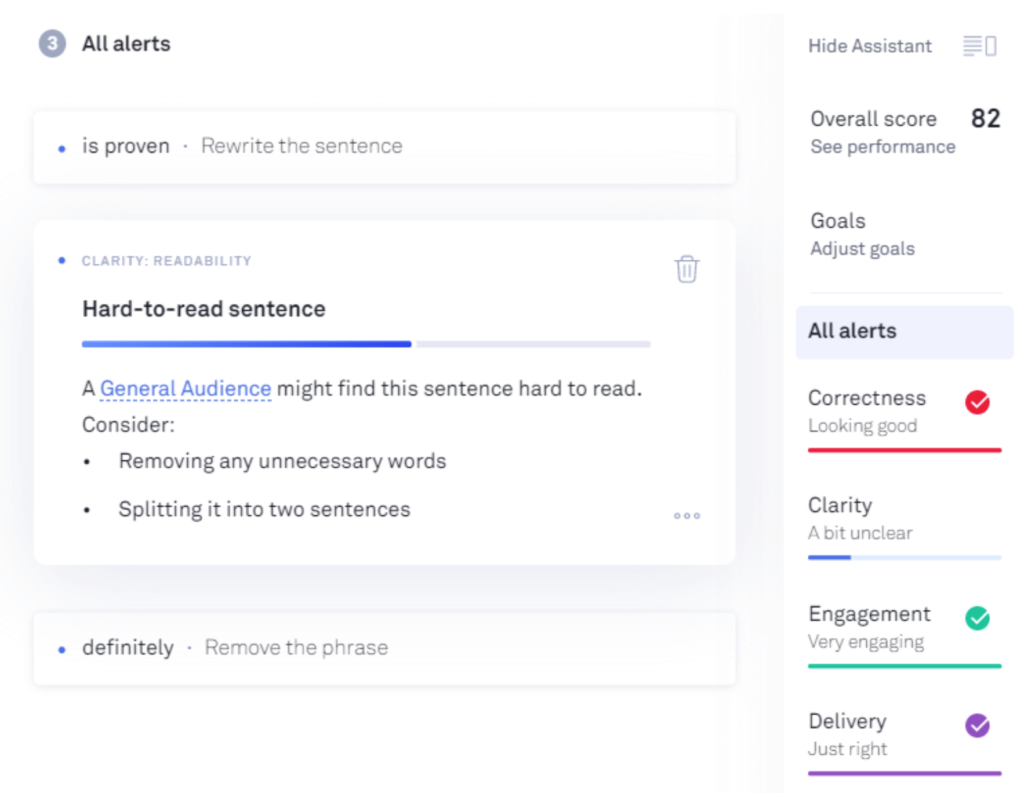
The way they come up with your performance score is they compare it to documents written by other Grammarly users who set the same goals you did and calculate how accurate your document was as opposed to theirs.
Apart from the website editor, we also use its extension which shows us red alerts every time we do errors during our writing in Docs. We trust it but we don’t rely on it. It can be wrong and is not to be trusted blindfoldedly.
In addition, Grammarly also has a plagiarism checker which is quite useful.
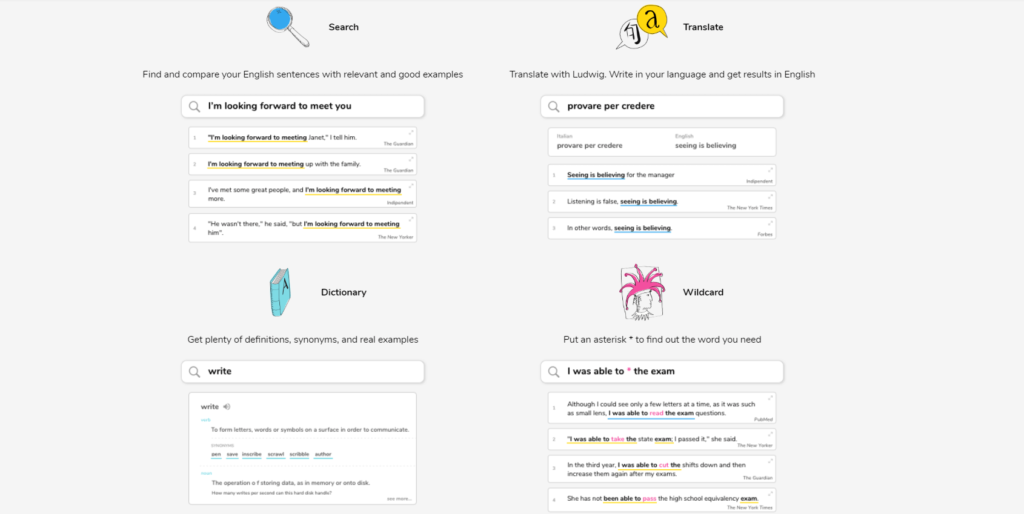
Ludwig.guru is an amazing tool for when you’re not sure whether a sentence your wrote makes sense or not. Ludwig has over 120 million of sentences from various sources of English writing such as scientific journals, established newspapers, etc., examples of which get shown after you type in a certain word, phrase, or sentence. This is especially useful for writers for whom English is not their first language.
They have other features, but the search bar one is the one we find most beneficial.
Needless to explain, a dictionary and thesaurus is an essential tool to have in hand. Either to find the definition of a word, a synonym or an antonym, they are a writer’s best friend. Here are some we recommend:
In cases when you don’t have a content style guide to write by, using existing famous stylebooks is also great. We like The Associated Press Stylebook best and base our style guides on it.
A couple of the books we keep on our literal and virtual bookshelves are:
How often you use your keywords matters. But especially for large articles, it’s difficult to keep track of every time you use them. Sure there’s CTRL + Find, but that’s manual work we’d rather not be doing. Keyword Density Checker scans your text and finds out the number of times you have cited each keyword.
The Hemingway Editor is an editing tool similar to Grammarly. It shares suggestions on readability and simplicity and provides a “grade level” for your writing.
SearchEngineJournal gives a great metaphor relating to internal linking:
If you think of SEO as a house, internal linking is the framework of that house. Internal linking provides the flow of traffic, allows you to navigate the space from room to room, and makes the space comfortable and intuitive. When you think of it this way, why would you build a blog without internal linking?
Therefore, always include at least a few internal links in long-form content. Here are some tips in this aspect:
Make sure that the anchor text of the page you’re linking to is descriptive of the page and is not longer than 5 words. It’s also good if one of the keywords that were targeted in the said article is used.
E.g. in guest posts written to promote our client’s article “Top 10 Types of Employee Training Programs”, we linked it using anchors that were close, but not identical to the keyword we targeted which was “types of employee training” or one of the supporting keywords.

External links are viewed by search engines as third-party endorsements of your website.
So, do link to high-quality external sites. (Emphasis on “high-quality”.)
Linking to reputable external sites adds value to your content piece (and even website), and makes it more trustworthy. Except for credibility, the quality of your links also impacts how high your page ranks in search results.
Additionally, using outbound links can also help establish a network with other professionals of the field you link to. Sharing their website as a recommendation to your audience can encourage them to do the same.
We usually hear the word “scannable” when it comes to this advice, but the term “skimmable” might be even more fitting. According to the Cambridge Dictionary, it means:
‘to read or consider something quickly in order to understand the main points, without studying it in detail’
Q: How does the reader try to quickly understand the main points of a long-form blog post?
A: By reading through the:
Q: So how do we make content more skimmable?
A: By incorporating the aforementioned.
From skimming to skipping.
Be ready not only for your readers to skim your article but to only skip to a part they’re interested in. especially for long guides which have many headings (such as this one that has as far as H6 heading tags). A table of contents with links to the chapters enables readers to easily skip to what’s relevant to them. Double points if it stands static on the side so that people can navigate through it without scrolling up to the beginning.
As SiegeLearn teach in their CM course, apart from helping the reader, this practice also adds SEO value to your page by including long-tail anchor text at the top of the page.
Blog posts with over 1,000 words tend to do better in search engines. The reason? More complete article, added value.
At Manaferra, we like to go for the Top 10 Average Method, i.e. find the average length of the top 10 results… and top that.
But no need to waste time adding and subtracting for that. You can either use this free Word Count Checker or SEMrush’s SEO Content Template to do it for you. The latter generates for us the data we need from our competitors (top 10 results on Google that targeted the keyword we’re using). Amongst that data is also the average length.
E.g. the average length of top articles targeting “employee training programs” is 1128 words. In this case, we’d go for an article over 1200 words long.
When you just don’t have anything else to write about regarding the chosen topic, LSI keywords can help.
LSIgraph.com helps with finding LSI Keywords which are other terms that are closely tied to what you just wrote about, enabling you to speak on related topics to your main topic, therefore, giving more depth to your content piece.
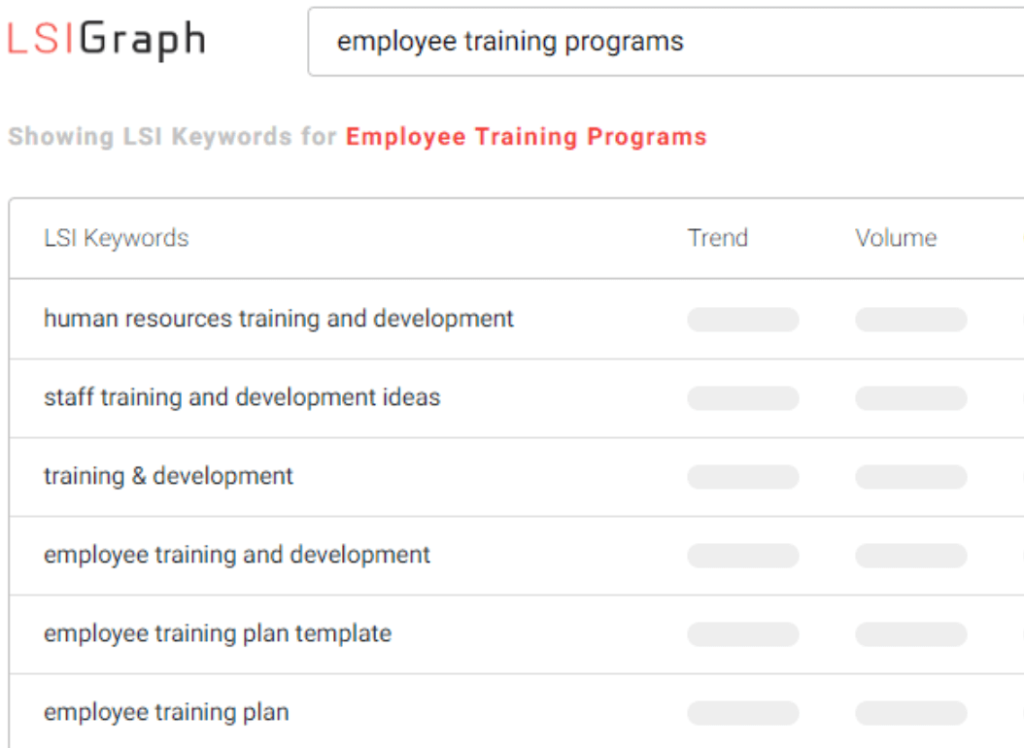

Be it a stock photo, a graphic, screenshots, tables, or even gifs, it is advisable to visualize your written content throughout the article.
Using stock photos is the easiest way to visualize your writing. They are widely popular and rightly so.
To the generous photographers that upload their work on these sites for free: thank you.
It’s very important to have a good eye for the pictures you use. See below some stock photos you should just scroll past, and the ones to stop and hit Download.

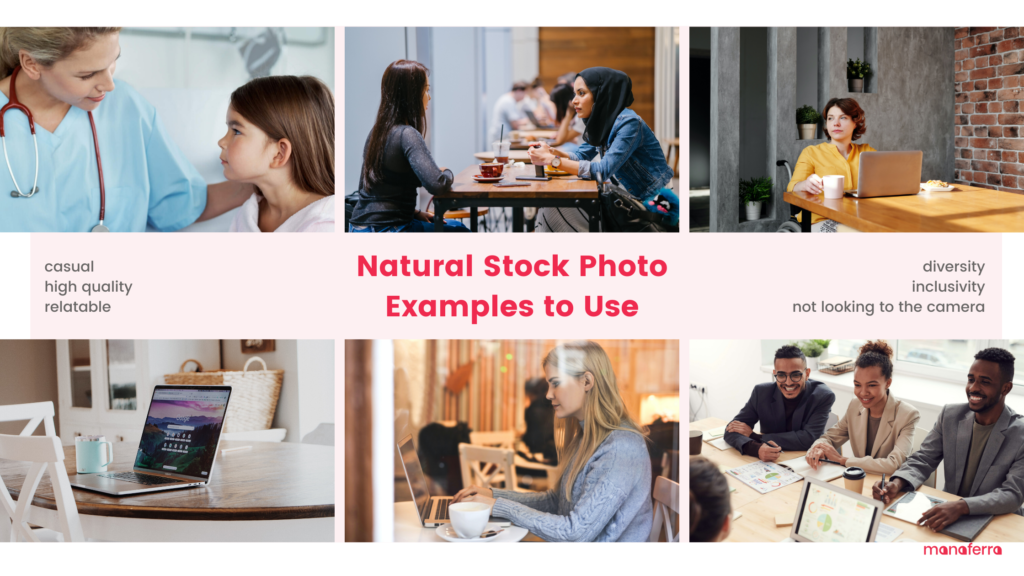
These tools will make you feel like a designer and help visualize what you wrote:
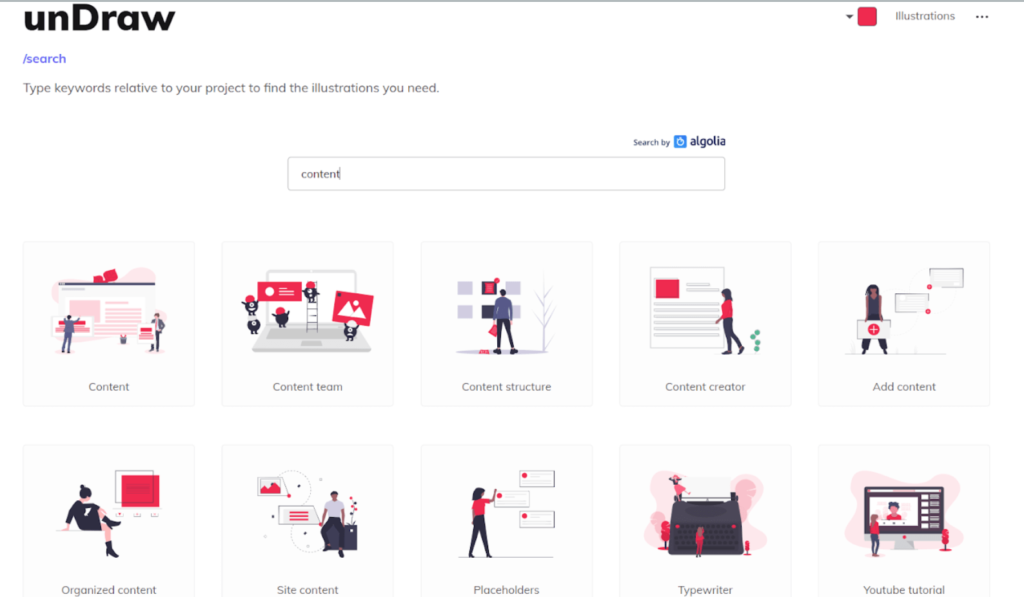
Illustrations are how you can give your content piece an extra oomph; and Undraw is how you can make yourself feel like a designer.
Undraw is an open-source illustration collection. Didn’t know those existed? Neither did we. This site was a pleasant discovery we’re glad we run on and about which we can’t shut up about.
A great feature is that you can customize the color of the illustrations to match your brand. When you’ve found one that matches your vision for your post, download it as either PNG or as SVG. The latter is suitable for when you want to take your design further and you need it saved as a vector. It can easily be transferred to Illustrator or Canva for further edits.
Canva is an amazing and easy tool for content writers to master. Especially if your team doesn’t have a designer.
If you’re creating a graphic yourself, don’t forget to put the brand logo on the lower/upper left/right corner of the picture. E.g.
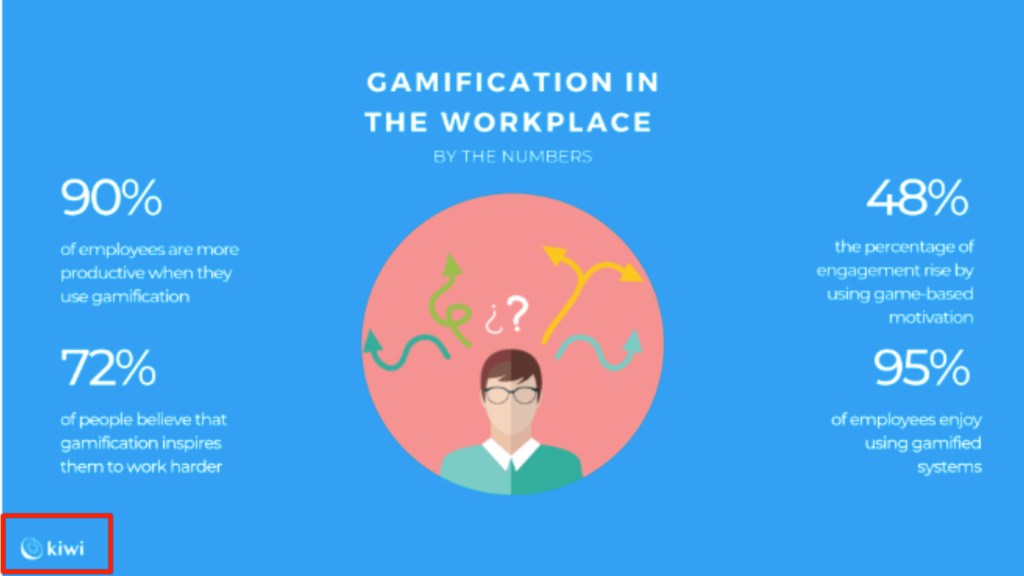
DataWrapper is a tool that enables you to make responsive charts, maps, and tables with no coding skills required. We used it for this interactive map. Example:
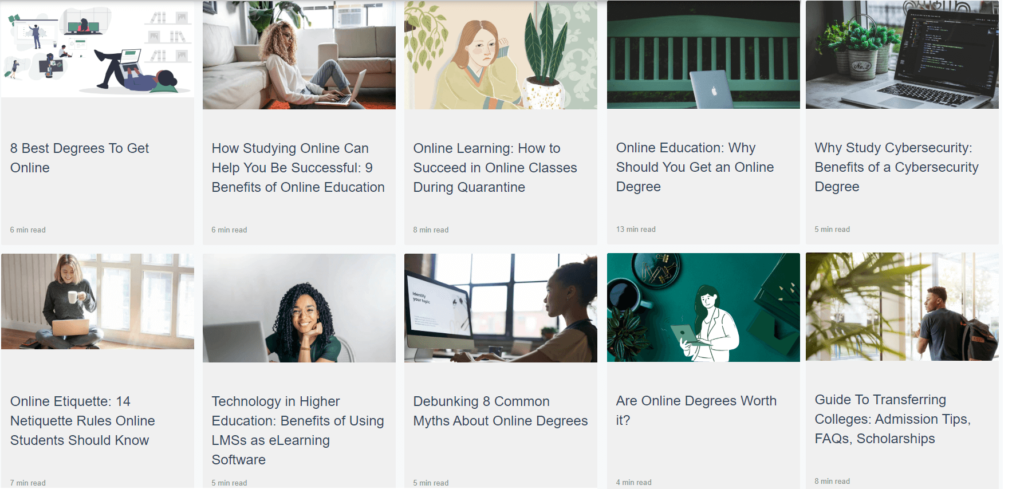
Think of your blog as your Instagram feed. You will want your posts to look good near each other and have some type of consistency that personifies you. Do the same for the clients you write.
On-page image captions and keywords in the surrounding text area also help search engines derive more context for images and improve their ability to rank. Where appropriate, try to write image captions under the image (centered). When using a non-royalty free image, you must put the source in the image description to give credits to the owner.
Yes, images need to be optimized, too.
Image optimization is crucial to avoid slow page load times, but there’s also such thing as image SEO. That is, getting your (most often: product) images to rank on image search engines. Here is how to optimize the pictures you use on your blog post.
The easiest optimization to pictures we can do is name the files correctly. Image file names should not look like this:

Sure it is easy to insert them in the article as soon as we download them, but it is crucial that they are renamed appropriately.
As SearchEngineLand also suggests, file names should contain ‘a few carefully chosen keywords – ideally, keywords the image could rank for – while omitting stop words (a, the, in, of, etc.) and separating keywords by hyphens.
For example, IMG-458752.jpg would become waiter-serving-food-restaurant.jpg.
Therefore the proper way to name this picture would be:

An alt tag, also known as “alt attribute” and “alt description,” is an HTML attribute applied to image tags to provide a text alternative for search engines. Alt tags ‘help images rank higher in search, but also build the page’s relevancy and improve user experience’.
Alt tags should be short and contain the target keyword, however, unlike file names, they should be written in a grammatically coherent and concise way. They should also be descriptive of the picture.
As much as we want to use pictures with the best resolution possible no matter the size, the image size actually CAN affect page load time. Try to save images under 200Kb or use compressing tools such as TinyPNG or Image Compressor to downsize large images.
For example, if we were to use this picture in a blog post, it’d be best to download either the Medium size version or a certain custom size. The next step to take would be using TinyPNG.
Additionally, if you’ll be doing the publishing yourself, it’s also a good idea to download a WP image compression plugin such as reSmush.it. It optimizes all your website’s pictures in bulk.

NOTE: Decide on the size of the image depending on the width of the blog layout of the website where your article is going to be published.

You’re almost done now. It’s time for a final check.
After making sure your article is all good by Grammarly’s rules, give it another check on SEMrush’s SEO Content Template Real-time Content Check. You only have to give the keyword you targeted and it will detect:
(which you’ll have to shorten or break down)
You’ll see if you reached or surpassed the target word count. It’s preferable to write fuller, longer articles than others have. So, meet the target, but write more if you have something to say.
Use them at least once, but 2-3 times is welcome, too.
Whether it contains the target keyword, whether the character length is within Google limits, and whether it has the right amount of words)
A good content writer should know what tone of voice to use according to the brand they are writing for. It can be useful to research how the customer already talks about the product or service to its users. Therefore, it’s important to know your target audience.
NOTE: When possible, ask the client for brand guidelines in regards to content writing and their tone of voice. If they don’t have something documented, then give their website/blog a quick scan and see how they write, then try to mimic that.
In any way, long, hard-to-read sentences should be avoided as they are not reader-friendly (let alone SEO-friendly). Try to convey your thoughts in short, clear, precise sentences. Don’t beat around the bush, get straight to the point!
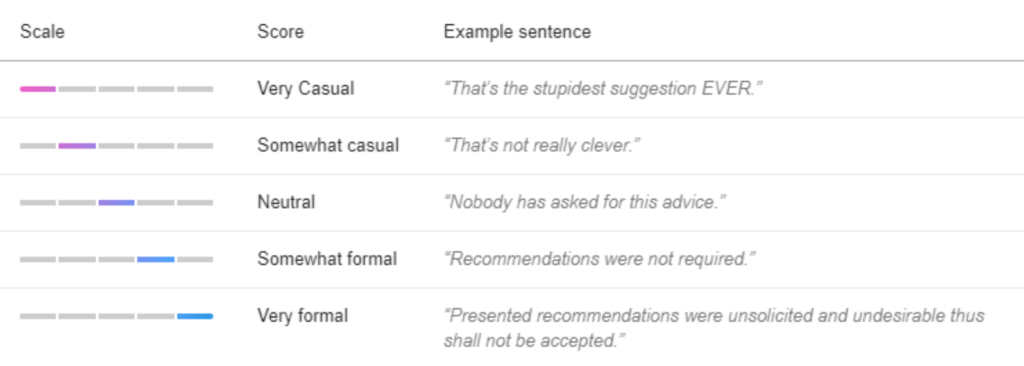
E.g. The readers of a higher-education institution are predominantly students, so the tone of voice should be casual to neutral, yet keeping it professional. For websites with an older, more educated audience, the tone should be somewhat more formal, but still conversational (and using active voice). These are ideally defined in the Content Style Guide created for the client to leave no space for confusion.
You know have a finished content piece you’re proud of. But is your work is finished? Well, not quite.

We are hired to produce content for a reason, whether it is to increase awareness of a brand, to drive traffic to a website, or to generate leads for a client. For these to happen, our content needs to reach its audience. And for this to happen, we need to promote it. Besides, content writing without the promotion part wouldn’t be content marketing at all.
Twitter, LinkedIn, Quora (yes, Quora), email marketing, targeted sharing, cold outreach; these are just some of the ways to promote your content post-publishing. However, sharing all the promotion tactics is out of the scope of this guide on ‘How to Write SEO-Friendly Content’—it deserves its own process. As of now, read the strategies OrbitMedia and CMI suggest.
This process, as everything in an industry as fast-growing as content marketing, will change constantly; new automation tools get built, new ideas, new sharing platforms. So, it’s good to be updated often.
Let us know if you gave this process a try and whether it worked for you. We’d love to know!

Content Specialist
Dafina is a Content Specialist at Manaferra and everyone’s favorite resident photographer. Apart from her love of capturing moments in time, her need of finding a non-traditional job with an English degree drove her to Manaferra. Here she is able to do what she does best—create SEO content, content marketing strategies, and all the work that drives our clients’ visibility, traffic, and conversions.
Dafina is a Content Specialist at Manaferra and everyone’s favorite resident photographer. Apart from her love of capturing moments in time, her need of finding a non-traditional job with an English degree drove her to Manaferra. Here she is able to do what she does best—create SEO content, content marketing strategies, and all the work that drives our clients’ visibility, traffic, and conversions.
Stay up to date with the latest marketing, sales, and service tips and news.